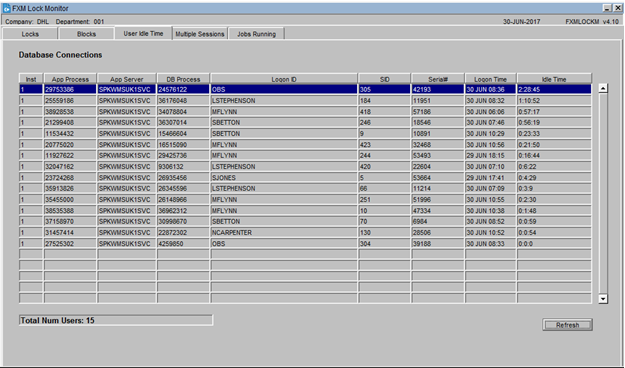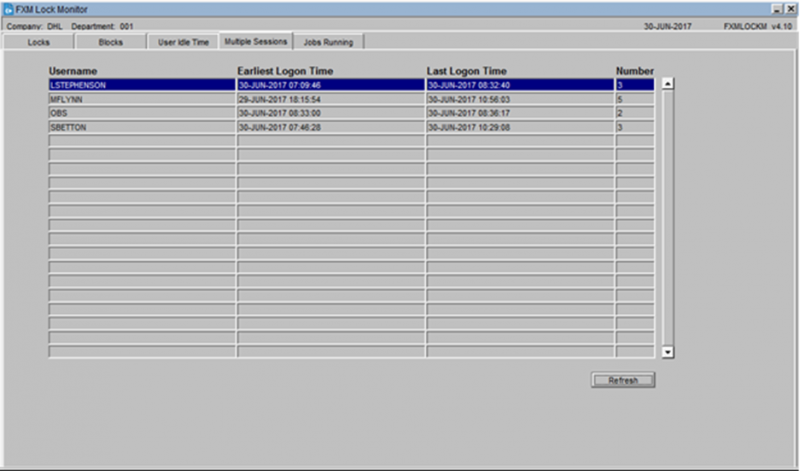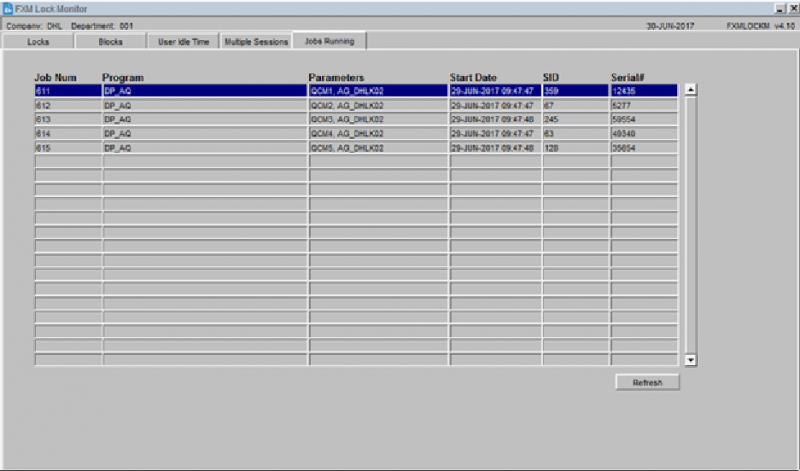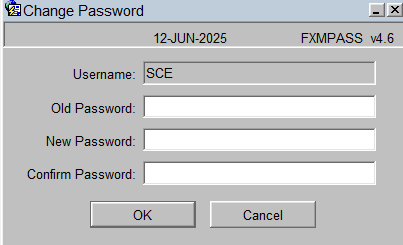FAQ
Common Queries and Questions
How to Allocate Held Stock
Set up:
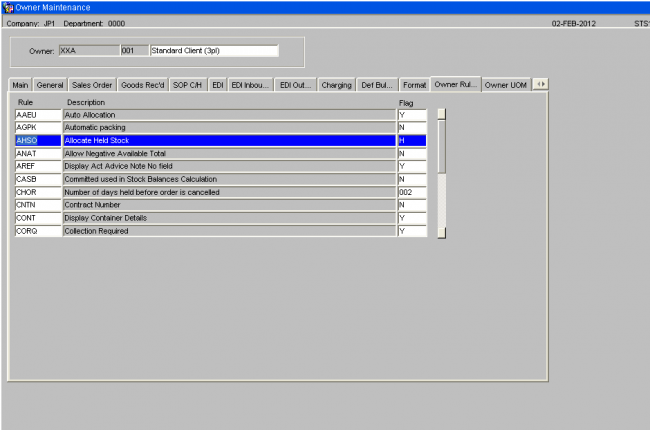
Ensure that the Owner Rule ‘AHSO’ is set with a value of ‘H’ This will enable the allocation of held stock functionality to work with line type ‘R’ orders only.
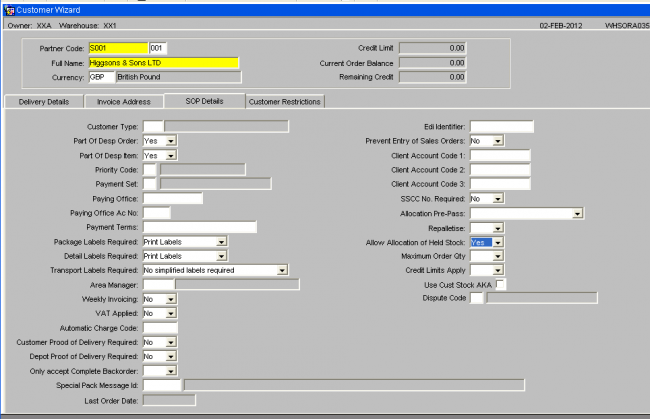
Against the Customer code, witin the SOP Details tab ensure the ‘Allow Allocation of Held Stock’ flag is set to ‘Yes’.
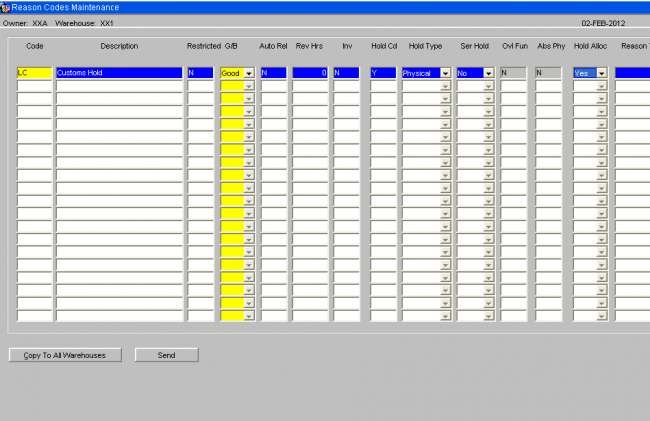
Within Reason Code Maintenance, ensure the Hold Alloc flag is set to ‘Yes’
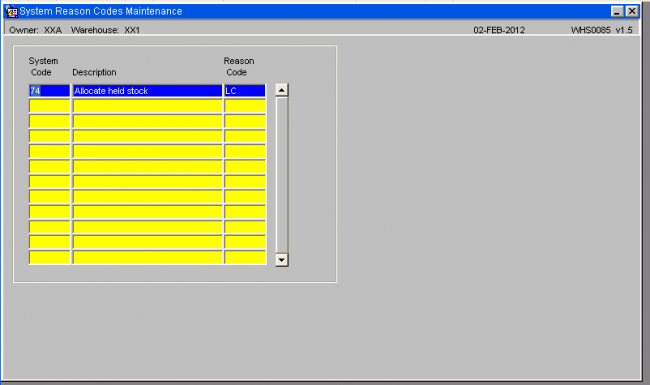
Link the Reason Code to a System Reason Code of ‘74’

Ensure the stock is held with the reason code ‘LC’
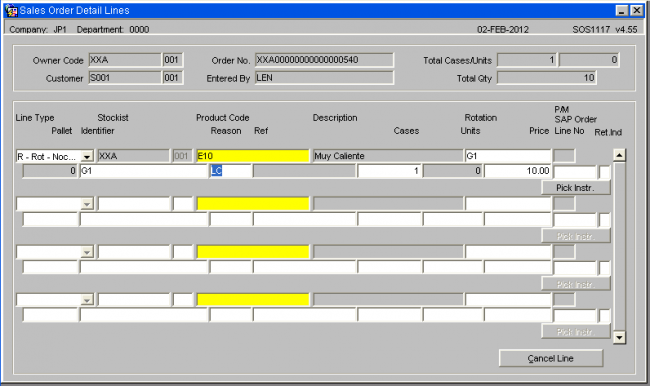
Enter a new order for a customer which allows allocation of held stock. Select a line type of ‘R’ select the rotation for the held stock and then enter the reason code and the cases to be allocated.
The order is then processed as standard.
How to Control Sell by Dates
1. Min Intake Life is the time that any item will remain in the warehouse, in addition to the time it will be on the shelf in the retail outlet.
2. Issue Life is the minimum time any item can be held in the retail outlet. If the time between today and the ‘Sell By Date’ is shorter than the ‘Issue Life’ days entered in the stock Maintenance then the system will not allocate that item
e.g. Time in warehouse = 120 Days
Time in Retail outlet = 60 Days
Therefore “Min Intake Life” is 120 + 60 = 180 Days
And the “Issue Life” = 60 Days
Any item that is within the ‘Issue Life’ timeframe (i.e. in the warehouse with less than 60 days to its ‘sell by date’) will not be allocated.
3. The “Max Intake Life” can be set at any figure greater than the “Min Intake Life” and is designed to give the stock holder some control over having outlandish ‘sell by dates’ which are too far in the future.
You can set these figures to whatever suits you as an warehouse operator but remember that the difference between the ‘Min Intake Life’ and the ‘Issue Life’ has to be long enough to allow you to perform all your normal warehouse operations from receipt to despatch (including allocation).
Incidentally you can always check the state of your ‘sell by date’ stock by running the “Out of date Stock report” which is in the Warehouse reports menu. From the above example were you to input a date 60 days in the future it would show you what stock was in the warehouse that had gone into its ‘issue Life and therefore couldn’t be allocated.
How to Create a Pick Walk Sequence
Within the WMS there is the ability to configure a specific pick walk sequence through the warehouse to help maximise picking efficiency.
WMS Set Up -
Owner Maintenance (STS1000)
- Format Tab
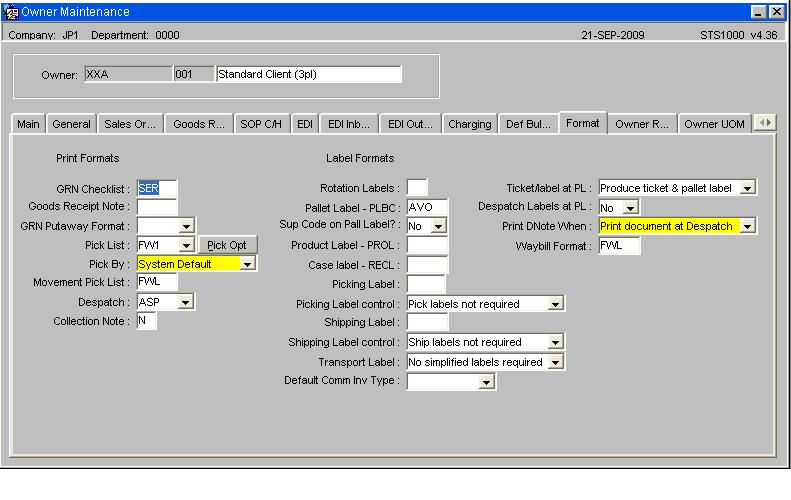
Key Points
Pick List Format must be set to FW1
Pick By System Default
Select the Pick Opt button to call an additional options box
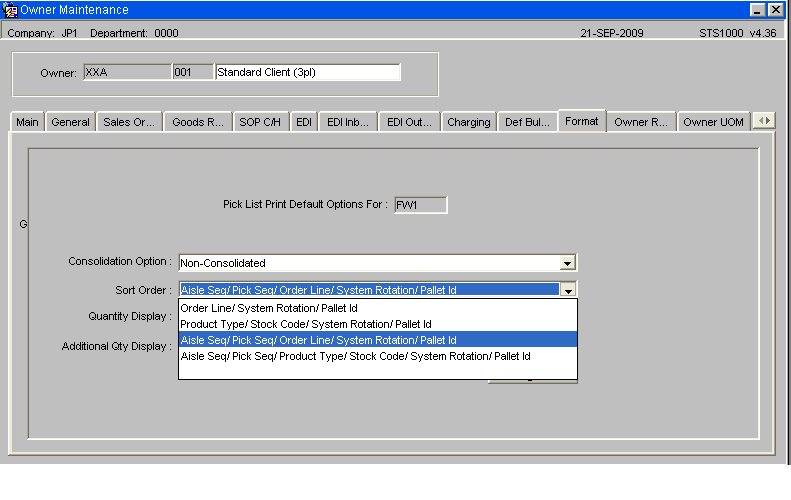
For a greater control and efficiency over the pick walk sequence select either a value of 3 or 4, so that the picking tasks will be sorted by location.
Aisle Sequence Maintenance (WHS0060)
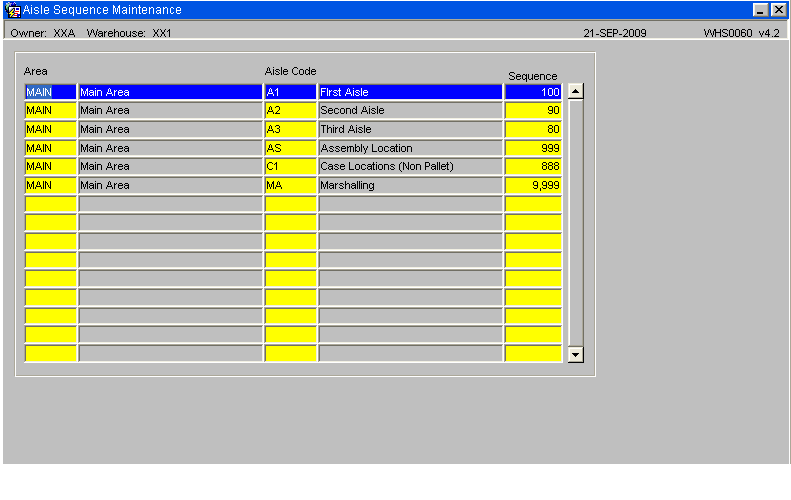
The sequence set against the aisle will help determine the sort sequence for the pick tasks, in the example above the pick tasks will be sorted in the following sequence A3, A2 and then A1.
Location Maintenance (WHS0090)
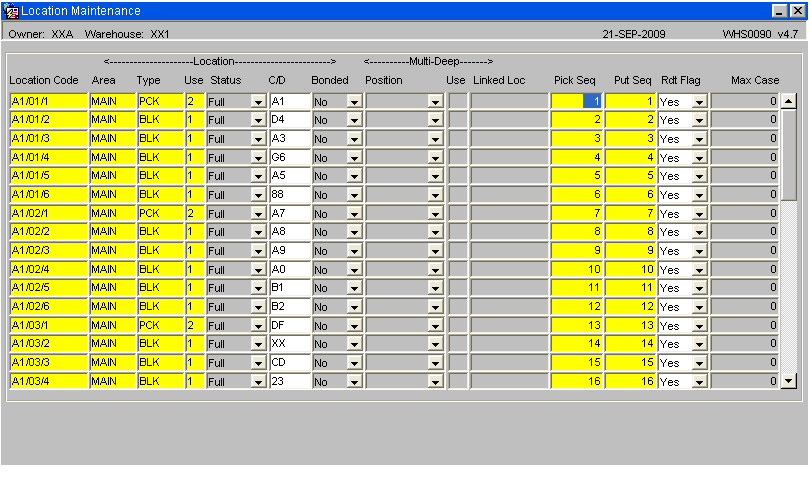
The Pick Sequence set against the location code will determine the sort sequence within a aisle for the picking tasks.
Putaway Re-Sequence Generation (WHS0472)
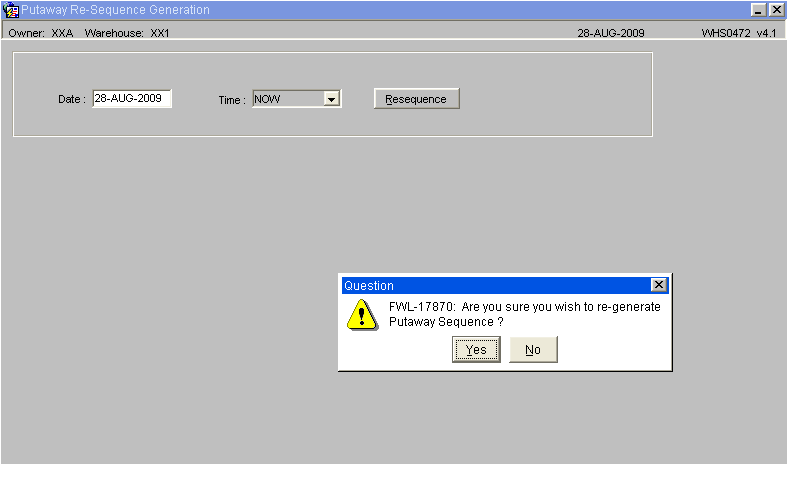
The Putaway re-Sequence Screen will generate both putaway and picking sequence numbers for the location codes.
NB: This will create a basic sequential count beginning at 1 for each individual aisle. It will also overwrite any existing records.
Free Locations (WHS0091)
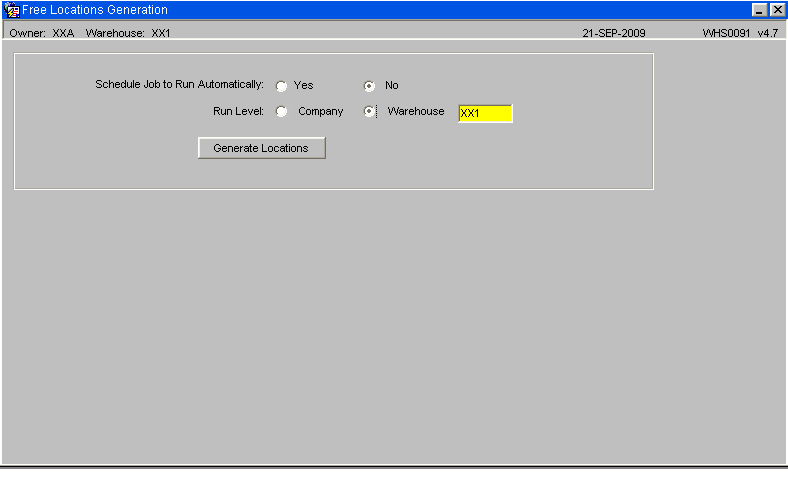
Once the Aisle and Location code have been assigned their sequence numbers, then run Free Location Generation which will create the Aisle Pick Sequence which is used to sort the picking tasks.
Printer Setup
Obtaining the printer name
Obtain the printer name as held on the print server from either the system administrator or logon on to the print server and execute the 'lpstat' command to list all printers on the server.

Printer configuration and Maintenance
Below are the steps required to set up a printer on the WMS system
Print Queue Maintenance (PHL3510)
Used to link printers on the print server to the WMS application
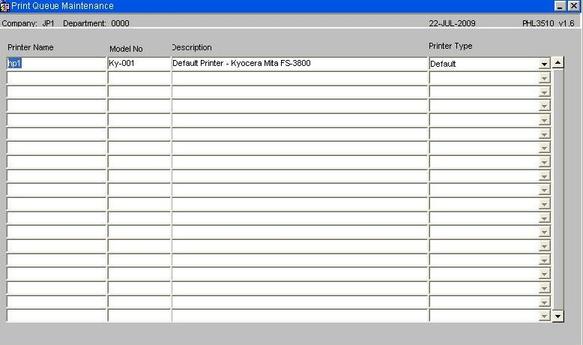
| Field Name | Description | Options | Generic Value |
|---|---|---|---|
| Printer Name | Name of the printer as held on the server | The field is case sensitive and must match the name on the server (see below) | Defined by site |
| Model No | Model Number of the printer | Free text field | Defined by site |
| Description | Free text field | Printer name as known in the warehouse | Defined by site |
| Printer Type | As selected from the drop down list | Default - HP Laser Jet - Line Printer |
Printer Groups (PHL3520)
The screen is used to group printers together, which might be by type, such as all zebra printers or possibly by area such as a warehouse or an area within a warehouse.

| Field Name | Description | Options | Generic Value |
|---|---|---|---|
| Printer Name | Name of the printer as held on the server | The field is case sensitive and must match the name on the server (see below) | Defined by site |
| Group Name | Specifies the group name for the selected printers | 20 character free text field | Defined by site |
| Desc | Descriptive name of the Printer group | 180 character free text field | Defined by site |
| Printer Name | The Printer name as held on the server | Must exist in Print Queue Maintenance | Selection from LOV of existing printers |
Output Manager (Runjob)
This screen allows the user to specify the device the print job is to be sent to, such as to screen or to a printer etc.
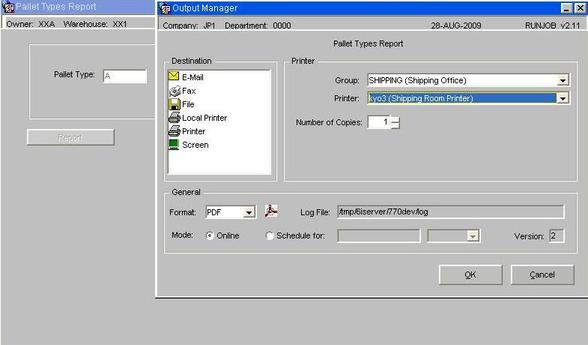
The output manger will default in the last Printer Group and Printer used, though there is the option to select an alternative if required.
Default Printers Maintenance (WHS0002)
The form is used to assign a default printer for specific documentation such as a report or label print to a user.
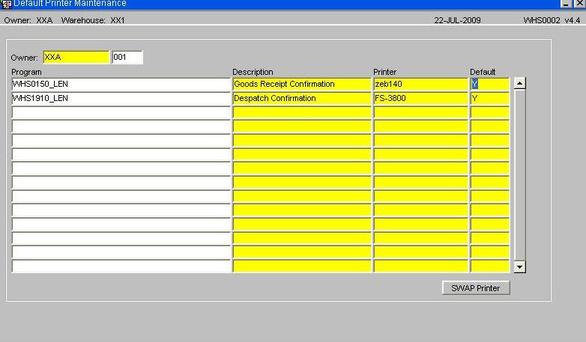
Note: Not all programs, reports and label formats are called from this screen. Below is a list of current programs which use this funtionality. Aptean will advise which report and label formats can be used.
| Field Name | Description | Options | Generic Value |
|---|---|---|---|
| Owner | Client or owner code as set-up on the system | The user will be able to select from a list of valid owner codes | Defined by site |
| Program | The calling program that will generate the report or label output | The program id is entered followed by an underscore character and the user id of the person who will require the print option. | Existing program that can call the Output Manager |
| Description | Description of the process as entered in the program field | Will default from system level information | N/a |
| Printer | The default printer the print job is to be sent to | As maintained in Printer Queue Maintenance | Defined by the client |
| Buttons | |||
| SWAP Printer | Allows the user to change a printer for another one without having to change each line | ||
Table of existing programs that are called by the Default Printer Maintenance Screen
| Calling Program | Description |
|---|---|
| WHS0150 | Goods Receipt - Conf |
| WHS0520 | Generated Pallet Movements |
| WHS0530 | Driver Ticket Reprint |
| WHS0630 | Stock Adjustments |
| WHS0700 | Stock Movements |
| WHS0710 | Generate Stock Movements |
| WHS0915 | Pallet Enquiry |
| WHS1714 | Pick List Confirmation |
| WHS1900 | Despatch Print |
| WHS1910 | Despatch by Route/Load |
| WHS1941 | Shipment Label Print |
| WHS1945 | Order Packing |
| WHS2054 | Change Ownership of Stock |
| WHS7886 | Goods Receipt Using RDT |
| WHR1702 | Picking Label Program |
| WHS1700 | Pick List |
| WHS1710 | Pick List Confirmation |
| WHS1721 | Packing List |
Printer Address Maintenance (PHL3530)
Used to automatically send print jobs to an external 3rd party server for printing, this is achieved by sending a flat file directly via ftp, circumventing the need to run the job through the XF monitor process.
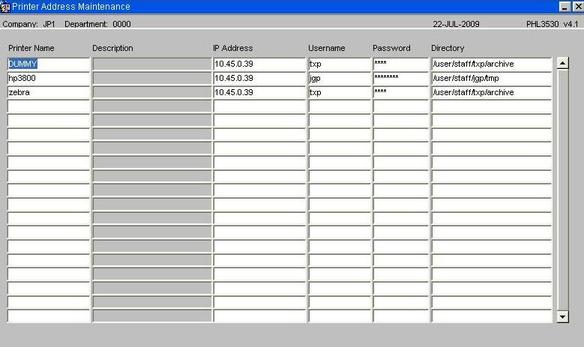
| Field Name | Description | Options | Generic Value |
|---|---|---|---|
| Printer Name | Name of the printer as held on the server | Printer associated with a specific packing station or stations | Defined by site |
| I.P. Address | I.P. address of the external server | Defined by site | |
| Username | Username of the account on the external server | Defined by site | |
| Password | Password of the account on the server | Defined by site | |
| Directory | Directory where the print job is to be delivered | Defined by site |
Silent Printing For Packing List
Ensure the following system registry settings have been added -
DefaultAsDirectory ‘/edistore’
BarCodeFontWHR1945 ‘xxx’
Within Default Printer Maintenance add the following setting -
WHS1945_LIST_LOGON
How to Re-Send WCS Messages
You should use the WCS Message Reprocessing screen WHS7921.
The screen is initially in entry mode and prompts for Queue, Status and Date. Any combination of these can be entered.
Usually the users will be interested in today’s messages and only those with an EXPIRED status.
Messages can also be at status READY and PROCESSED.
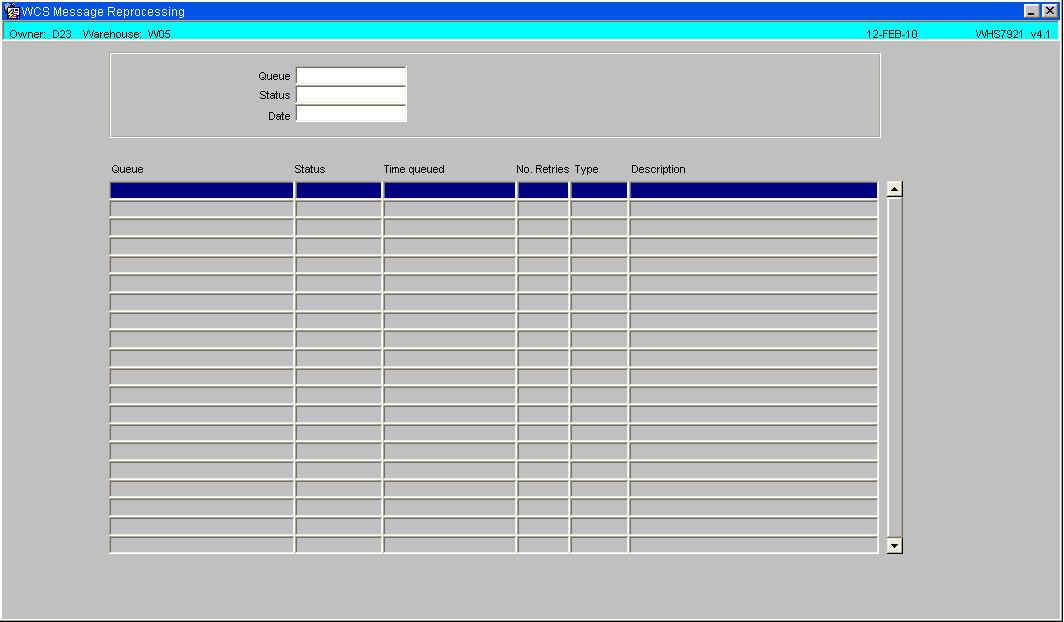
Message details will be returned:
The message type indicates what function the message is trying to do. For example, the 611 message is a pick confirmation and pallet move (moving the pallet from the pick face to the marshalling location). The 601 message is the Receipt update message, see below for the full list.
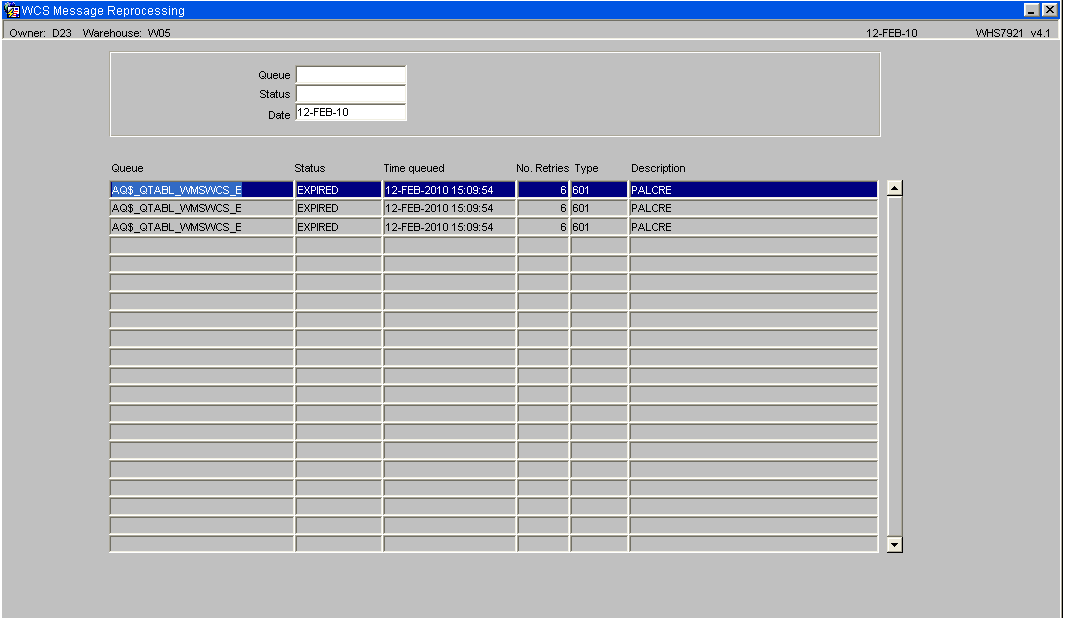
In order to resend a message, right click on the highlighted line and choose ‘Process’. You can also view the message – however it is one large text string so the contents are not immediately obvious. The message will then be sent to the queue and processing will be run again.
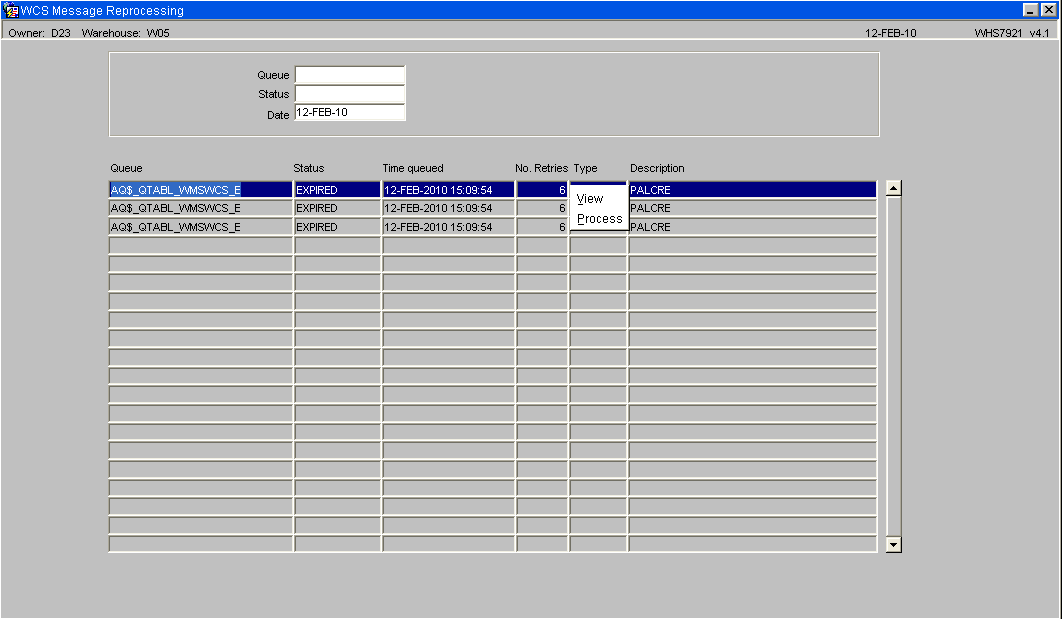
The message will only fully process if it is able – if there is a data issue the message could expire again. Where it failed originally due to record locks it should re-process as long as the lock blocking it has been released.
List of the most commonly used RF messages
- 601 - Receipt Update
- 611 - Pallet Move Update
- 621 - Pick Update
- 631 - Aisle Status Update
- 651 - Pallet Enquiry
- 671 - Stock Take Update
- 681 - Despatch Update
- 691 - Location C/D Validation
- 711 - Location Enquiry
- 721 - Owner Validation
- 751 - Pack/Shipment Update
- 999 - WMS Interface
Identifying Record Locks
You should use the Locked Record Monitor (FXMLOCKM) .
![]() Note: All info is shown at database level, so if there is more than one contract using the database then their info will be visible to anyone going into this screen.
Note: All info is shown at database level, so if there is more than one contract using the database then their info will be visible to anyone going into this screen.
First Tab Page – Record Locks
Shows any user or process (e.g. EDI or WCS) holding a record lock. The screen also shows how long they’ve been holding the lock, and which owners & warehouses they have access to.
If the screen shows ‘UNKNOWN’ for the transaction start time – this means Oracle is unable to provide it, however this is usually correct.
The third line shows that user JYR has been locking records PACK_HEADER & PACK_LEVEL) for approx 10 minutes (screen shots taken at 15:53pm).
The columns for SID, Inst & SERIAL# are for support purposes – they are not relevent to the operation.
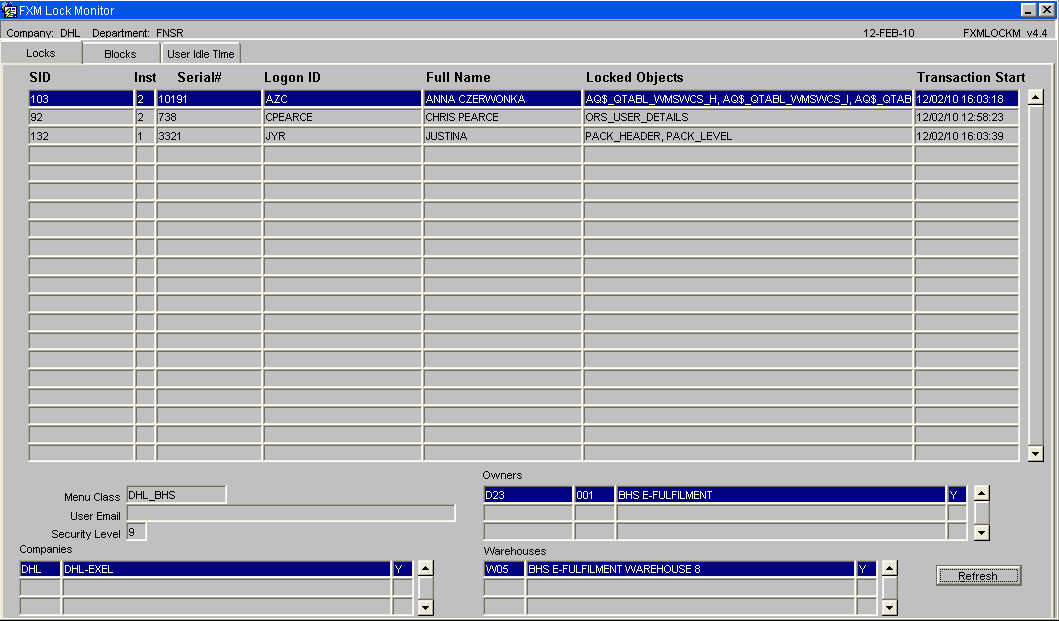
Second tab page – Blocking Locks
This is when one user is holding a lock on a record that another user also wants to update.
The user id of the person locking the record and the user id of the person being locked out are displayed and the table which is being locked.
The SID and instance are for support purposes.
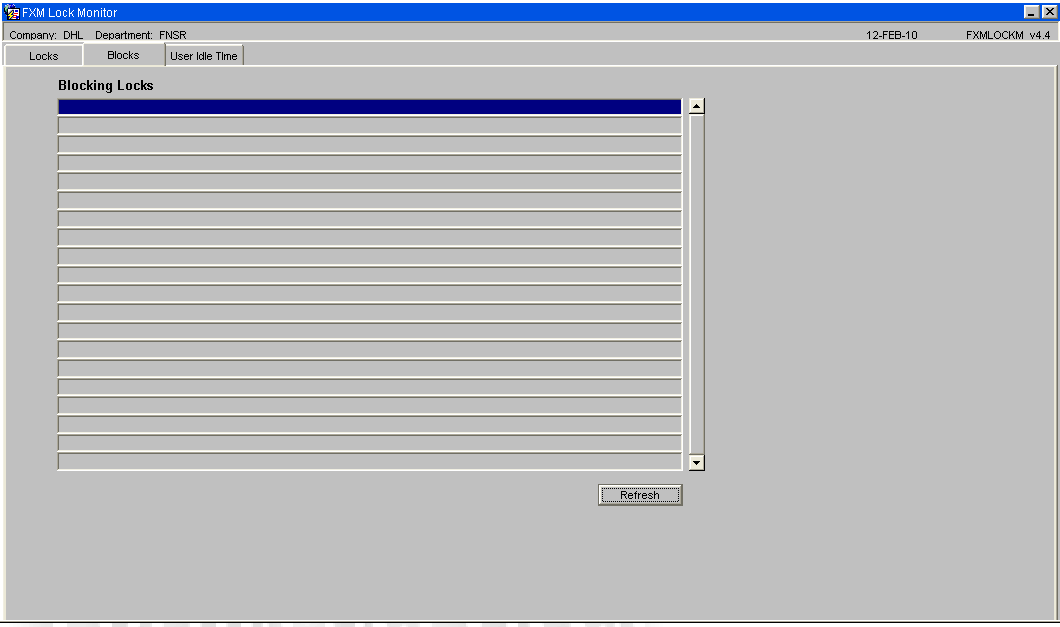
Third tab page – users on system
This lists the users connected to the system. The initial sort order is by Idle Time (i.e. how long since a user issued a command to the database).
All columns on these page can be used as a sort parameter. Clicking on the heading buttons sorts ascending, then with a second click descending.
Useful columns to site are really Logon Time and Idle Time.
Fourth tab page - multiple sessions
The fourth tab page shows if users have multiple sessions logged in under the same username. This isn’t an issue as such, but can be useful to ensure users are logged in with the correct usernames and aren’t locking themselves out with multiple sessions
Fifth tab - Jobs Running
The fifth tab page shows any jobs that are running. There are 2 types of jobs that will be seen – EDI runs and the WMS/WCS interface.
In the screenshot below, just the WMS/WCS interface is running – there are always 5 entries for this interface. EDI type jobs will have 1 entry for each – so 1 for products, 1 for orders – but only show when the EDI is actually executing an upload. The interface to WCS is always running.
How to Reset your Password
Use the option FXM Password.
This screen allows you to change your password.
Enter your old password and your new password twice. Then click OK - this will change your password. Click Cancel if you don't want to change the password.
